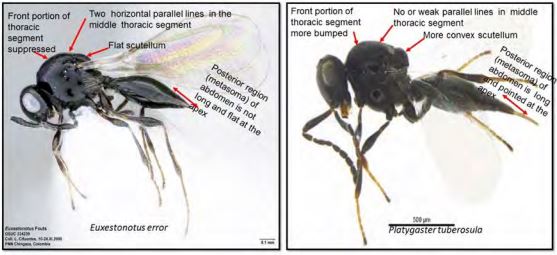Introduction of two Biocontrol Agents Euxestonotus error and Platygaster tuberosula for the Management of Wheat Midge Population in Montana
Principal Investigator: Gadi V.P. Reddy
Project Personnel: Govinda Shrestha, Dan Picard, Ramadevi L. Gadi and Debra Miller Western Triangle Agricultural Research Center, Montana State University, 9546 Old Shelby Rd., P.O. Box 656, Conrad, MT 59425, USA
Aim of the Study
The aims of this study were: 1) to rear two tiny black parasitoid species Euxestonotus error and Platygaster tuberosula under WTARC laboratory conditions and 2) to release the E. error and P. tuberosula at wheat midges infested fields in the Golden Triangle, Montana
Material and Methods
The release process of parasitoids were illustrated in Fig 1. Collection and storage of parasitoids
A federal import permit (Permit number # P526P-18-01709) was obtained by USDA-Animal and Plant Health Inspection Service on May 2, 2018, for the collection of Euxestonotus error and Platygaster tuberosula (Hymenoptera: Platygastridae) for Canada. In August 2018, about 25,000 wheat heads were collected from spring wheat fields of Langenburg, Saskatchewan, Canada. In 1993 and 1994, E. error and P. tuberosula had been released by Canadian Entomologists and are currently known to be established well in this region. After the wheat heads collections, parasitoids were immediately transported to Western Triangle Agriculture Research Center (WTAC), Montana State University. The wheat heads were spread out in an even layer and left at room temperature (19–22°C) to dry for approximately 2 weeks in the WTARC laboratory. De-awning machine was used to gently thresh dried heads. Midge larvae were separated from the seeds and the chaff with an air cleaner (Fig.1). Approximately 30000 larvae were harvested in this manner from 25,000 infested wheat heads. Harvested larvae were then placed in a soil-less mixture of vermiculite and sphagnum and stored at 2–4°C.
Fig 1. Whole release process of parasitoids
When to take out parasitoid larvae from cold storage?
Parasitoid larvae are currently stored at 5°C in 473 ml round plastic deli containers that had been filled with vermiculite and peat moss. Larvae were placed at the top surface layer of the containers. Each container contained 500 larvae. It is usually difficult to assess when would be the optimum time to take out parasitoid containers from the refrigerator and to begin rearing for field releases? Affolter (1990) described that parasitoids E. error and P. tuberosula emergences can occur within 4-5 weeks under laboratory conditions at 22oC. This study also demonstrated that parasitoid puparium can be formed after 18 days of incubation and the pupal stage could last for 12 ± 1.5 days (n=9) and 21 ±2 days (n=7) respectively, for male and female, under optimal conditions. Based on our 2016 parasitoid rearing experiences, we observed that all parasitoids often not emerge on the same time and saw 15 days variations in emergence timing. Therefore, it can be like a “catch 22” for when to take out parasitoids from refrigerator that can coincide with wheat midge emergence peak. In Golden Triangle, Montana, we have observed two trends on wheat midge emergence peak. For instances, midge emergence peak can be on June 30 to July 5 when the winter environmental conditions are mild, but on July 15 to 25 when conditions are colder. Therefore, these aspects will be taken under considerations for taking out parasitoids from refrigerators.
How to identify two parasitoid species?
The protocol to determine the morphological characteristic of E. error and P. tuberosula was developed with the great assistance of Peeter Neerup Buhl, a taxonomist working within the field of platygastridae. The criteria to identify the two parasitoid species are highlighted in Fig 2.
Fig 2. Morphological characteristics of parasitoids
How to rear parasitoids under lab conditions?
Based on our previous year’s experiences, it is expected that the parasitoid larvae will be taken out of the cold storage chamber from end of May to 1st week of June, 2019. The parasitoid larvae will be placed in plastic round deli containers. However, the containers will be first filled with garden soil and afterward the larvae will be placed in the top layer of the soil. These containers will be sprayed (hand sprayer) with distilled water (3-4 ml) to moisten the soil. When the parasitoids will be expected to emerge (3 weeks after incubation), all these containers will be taken out from the growth chamber and placed in insect cages where they will be further sprayed with distilled water at 1-2 days intervals. In each insect cage, about 5-7 plastic containers will be placed and the emergence of parasitoids will be observed every day. After 1-2 days of parasitoid emergence in an insect cage, they will be taken out with the help of an aspirator and kept in Petri dishes (1 parasitoid per Petri dish). These Petri dishes will be then kept in a cooler growth chamber (10°C) for 2 hours and subsequently, the parasitoid species were identified under a stereomicroscope.
When and where to release parasitoids?
Four to six highly infested wheat midge fields will be selected in summer 2018 in Valier and/or in areas that have high midge infestations. The midge infestation will be based on midge trap count data. Immediately after the fields’ selection, sweep netting activity (1-2 times before the parasitoids release) will be performed to assess whether there are presence of E. error and P. tuberosula prior to their release at field sites. Selected spring wheat producers will be requested for not to spray insecticide in release area or to inform us of their insecticide spray schedule. As a result, we could better plan for release dates of the parasitoids.
Results
The results of this study will be presented on 2019 annual report.
Acknowledgements
This work was supported by Montana Wheat and Barley Committee.
References
Affolter, F. 1990. Structure and dynamics of the parasitoid complex of the wheat midges Sitodiplosis mosellana (Géhin) and Contarinia tritici (Kirby). International Institute for Biological Control, Delémont.


